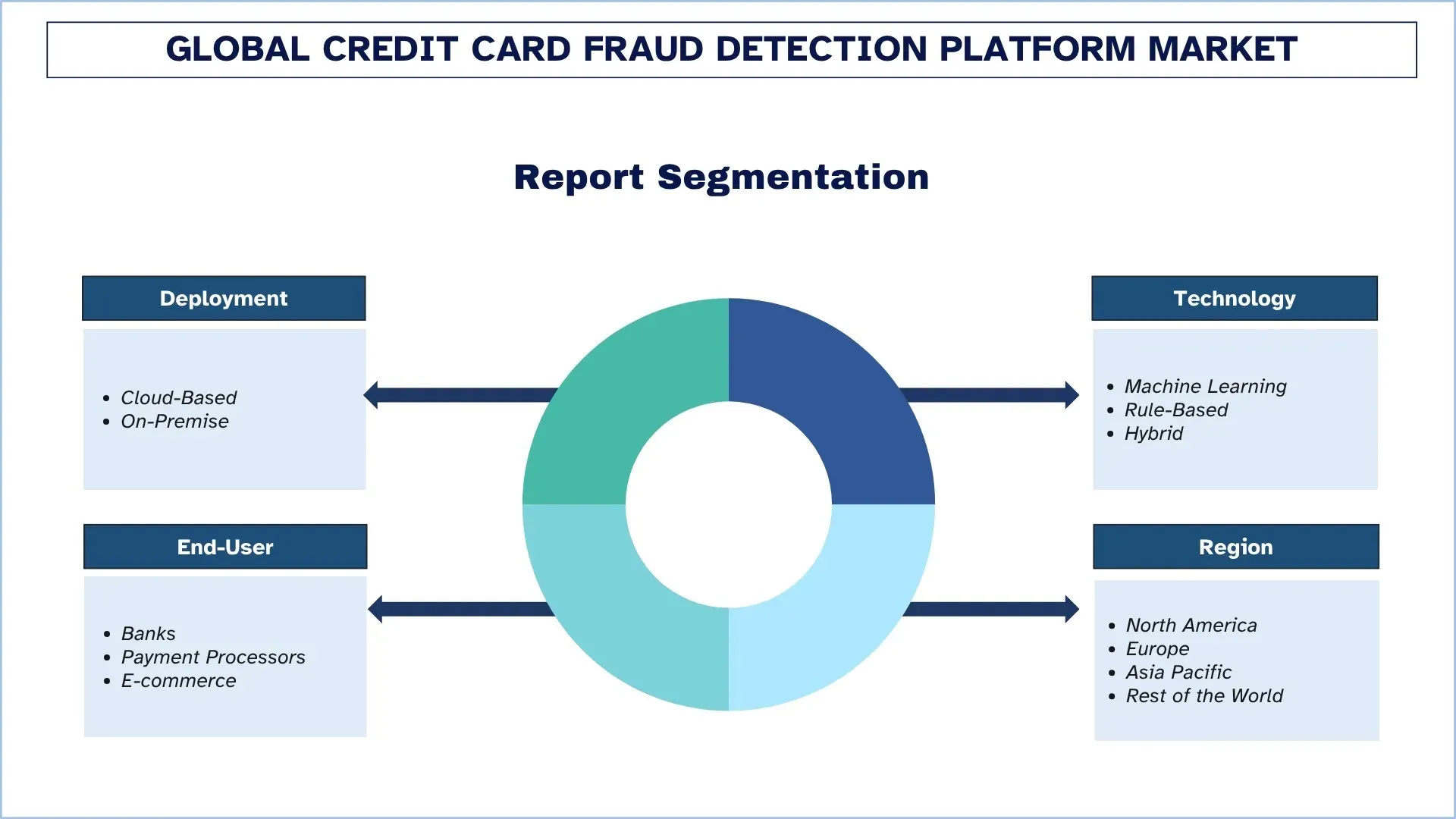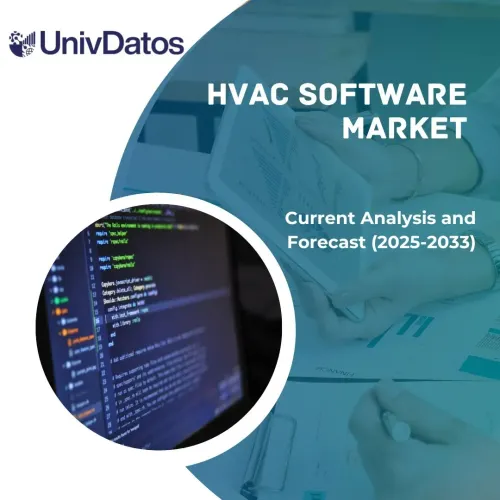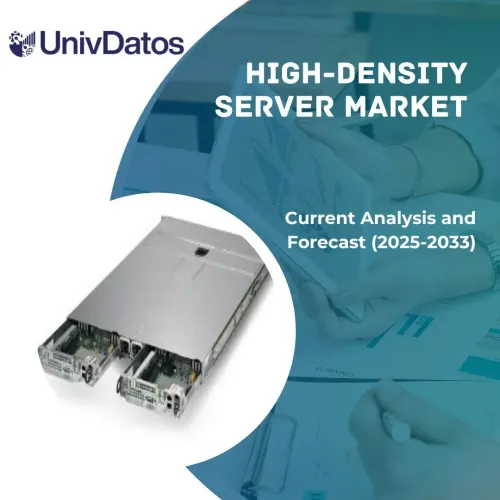- Home
- About Us
- Industry
- Services
- Reading
- Contact Us
Credit Card Fraud Detection Platform Market: Current Analysis and Forecast (2025-2033)
Emphasis on Deployment (Cloud-Based and On-Premise); Technology (Machine Learning, Rule-Based, and Hybrid); End-User (Banks, Payment Processors, and E-commerce); and Region/Country

Global Credit Card Fraud Detection Platform Market Size & Forecast
The Global Credit Card Fraud Detection Platform Market was valued at USD 4,332.80 million in 2024 and is expected to grow at a CAGR of around 13.86% during the forecast period (2025–2033F), driven by growing demand for secure and seamless digital transactions, driven by e-commerce expansion, online banking, and contactless payments, is prompting the use of advanced credit card fraud detection platforms to enhance security and ensure real-time threat prevention
Credit Card Fraud Detection Platform Market Analysis
The global market is encouraged by increasing rates of digital payment fraud in banking, e-commerce, and fintech sectors. Credit card fraud detection systems are necessary to analyze the patterns of transactions, detect anomalies, and thwart unauthorized activity with high accuracy, speed, and scalability. High-tech solutions based on artificial intelligence (AI), machine learning (ML), and behavioral analytics are under development and are already being deployed in real-time fraud prevention and identity verification. The general acceptance of cloud-based security infrastructure, the introduction of automation in fraud detection systems, and the pressure of consumers in seeking secure online deals are also further driving growth in the market. Privacy-compliant, energy-efficient, and adaptive fraud detection technologies introduced will contribute to the market becoming more resilient and sustainable over time.
Global Credit Card Fraud Detection Platform Market Trends
This section discusses the key market trends that are influencing the various segments of the global credit card fraud detection platform market, as found by our team of research experts.
Adoption of AI and Machine Learning Models
The market of credit card fraud detection platforms in the world is also changing significantly, and this fact can be attributed to the use of AI and the application of machine learning models. The simplest solution would be to shift towards more adaptive, learning, and responsive companies with increased complexity of fraud schemes moving higher and lower on the detection scale due to the increased sophistication of possible rule pattern modes used to detect system vulnerabilities and fraud. Machine learning algorithms and AI analyze large amounts of transactions to detect the subtle patterns of behavior and anomalies that can reveal fraudulent activity. In particular, machine learning can operate in real time to independently identify inconsistencies in how a user spends money, where they are, or what they are doing on their device to minimize unauthorized transactions before they happen. Major banks, transaction processors, and other tech companies are incorporating predictive analytics and neural network-based fraudulent classification algorithms to increase hit rates and minimize false hits. Moreover, ongoing training of the models also allows such systems to develop over time as criminals start using new methods of fraud, providing an active and proactive response to risk management. The usage of AI and machine learning models will be a major trend as the global payment ecosystems continue to digitize, giving rise to further innovations and strengthening the resilience of fraud detection systems across every corner of the globe.
Credit Card Fraud Detection Platform Industry Segmentation
This section provides an analysis of the key trends in each segment of the global credit card fraud detection platform market report, along with forecasts at the global, regional, and country levels for 2025-2033.
The Cloud-Based Segment Dominates the Credit Card Fraud Detection Platform Market
Based on deployment, the global credit card fraud detection platform market is segmented into Cloud-Based and On-Premise. In 2024, the Cloud-Based segment is expected to dominate the market and maintain its leadership throughout the forecast period. Cloud-based systems are becoming more popular because we can scale them, use them efficiently, and they can deliver real-time detection of fraud on various digital payment channels. These solutions can be effortlessly integrated with AI and machine learning algorithms to further enhance their predictive power and trade off false positives in transaction monitoring. The adoption of remote payment infrastructures, e-commerce transactions, and the growing usage of digital banking further contributed to the growth of the segment. Furthermore, the addition of enhanced cloud architecture security, adherence to international data protection standards, and increased capacity for implementing in older architectures are also making financial institutions switch towards cloud architectures. Cybersecurity demands are changing, and cloud-based fraud detection solutions will only grow in their constantly questioned and innovative characteristics, agility, and automation.
The Machine Learning Technology held the Largest Market Share in the Credit Card Fraud Detection Platform Market.
Based on technology, the global credit card fraud detection platform market is segmented into Machine Learning, Rule-Based, and Hybrid. In 2024, the Machine Learning segment is expected to dominate the market and maintain its leadership throughout the forecast period. The introduction of machine learning technology is gaining widespread adoption because of its capability to process large volumes of transaction records to uncover money laundering and adapt to changing fraud actions. Such systems naturally evolve as new information flows up to date and detect better and more accurately, with fewer false alerts. The increased demand for sophisticated and automated fraud prevention systems in the banking and financial services and e-commerce sectors is what drives the growth of the segment. Moreover, the growing number of AI-based analytics, natural language processing, and behavioral biometrics improves the power of machine learning models to predict and prevent sophisticated fraud cases. With the migration to risk management through proactive fintech progress, it is likely that machine learning-driven services will be the key to enhancing the payment security of consumers and providing a comfortable customer experience.

North America Dominated the Global Credit Card Fraud Detection Platform Market
North America currently dominates the world credit card fraud detection platform market and is expected to remain so during the forecast period. The region also enjoys the company of leading financial institutions, fintech firms, and payment service providers that early adopt advanced fraud prevention technologies. The U.S. and Canada are leading with innovation in digital payment because of the popularity of credit and debit cards, contactless banking, and online shopping platforms, which demand advanced fraud systems. The existence of stringent regulatory laws like PCI DSS and consumer protection laws continues to push organizations into investing in powerful security and fraud detection facilities. Also, the concentration of artificial intelligence (AI), machine learning (ML), and the development of behavioral analytics into payment security systems is improving fraud detection in the area, making it more accurate and faster. The potentially massive investment levels in R&D, the rise in cybersecurity awareness, and the concentration of global technology giants in the region make North America the most active region in identifying the future of the global credit card fraud detection platform market.
U.S. held a dominant Share of the North America Credit Card Fraud Detection Platform Market in 2024
The US credit card fraud detection systems market is steadily increasing due to the booming development of digital payments, e-commerce, and financial technology services. Some of the major factors relate to the growing need to have real-time analytics of fraud and the necessity of highly secure systems of transactions. In the U.S., there is increasing interest in AI- and machine-learning-based solutions, which contribute to the development of intelligent and adaptive fraud prevention approaches. In addition to that, the increase in the number of cases of online fraud and data breaches is driving growth in the use of these platforms, particularly in the banking, retail, and payment gateway markets. The focus that the nation gives to innovation and development of cybersecurity will guarantee the future growth of the market.

Credit Card Fraud Detection Platform Industry Competitive Landscape
The global credit card fraud detection platform market is competitive, with several global and international market players. The key players are adopting different growth strategies to enhance their market presence, such as partnerships, agreements, collaborations, new product launches, geographical expansions, and mergers and acquisitions.
Top Credit Card Fraud Detection Platform Companies
Some of the major players in the market are FICO, SAS Institute Inc., NICE Actimize, ACI Worldwide, Experian Information Solutions, Inc., Feedzai, Featurespace Limited, Equifax Inc., RSA Security USA LLC, and LexisNexis Risk Solutions.
Recent Developments in the Credit Card Fraud Detection Platform Market
On July 10, 2025, FICO was nominated with the Credit Award of Excellence in Fraud Prevention due to its implementation in Barclays. The system incorporated the newest Scam Signal technology developed by FICO to identify social-engineering attempts in the onboarding process and blocked several fraud cases on the first day of the system.
On February 18, 2025, Feedzai announced that it had partnered with Mastercard to expand its Consumer Fraud Risk (CFR) platform across the world. The CFR solution was first launched in the UK in 2023 and is reported to have reduced the number of authorized push-payment scams by more than 12, according to the UK Payment Systems Regulator.
Global Credit Card Fraud Detection Platform Market Report Coverage
Report Attribute | Details |
Base year | 2024 |
Forecast period | 2025-2033 |
Growth momentum | Accelerate at a CAGR of 13.86% |
Market size 2024 | USD 4,332.80 Million |
Regional analysis | North America, Europe, APAC, Rest of the World |
Major contributing region | North America is expected to dominate the market during the forecast period. |
Key countries covered | U.S., Canada, Germany, U.K., Spain, Italy, France, China, Japan, and India |
Companies profiled | FICO, SAS Institute Inc., NICE Actimize, ACI Worldwide, Experian Information Solutions, Inc., Feedzai, Featurespace Limited, Equifax Inc., RSA Security USA LLC, and LexisNexis Risk Solutions |
Report Scope | Market Trends, Drivers, and Restraints; Revenue Estimation and Forecast; Segmentation Analysis; Demand and Supply Side Analysis; Competitive Landscape; Company Profiling |
Segments Covered | By Deployment; By Technology; By End-User, and By Region/Country |
Reasons to Buy Credit Card Fraud Detection Platform Market Report:
The study includes market sizing and forecasting analysis confirmed by authenticated key industry experts.
The report briefly reviews overall industry performance at a glance.
The report covers an in-depth analysis of prominent industry peers, primarily focusing on key business financials, type portfolios, expansion strategies, and recent developments.
Detailed examination of drivers, restraints, key trends, and opportunities prevailing in the industry.
The study comprehensively covers the market across different segments.
Deep dive regional-level analysis of the industry.
Customization Options:
The global credit card fraud detection platform market can further be customized as per the requirements or any other market segment. Besides this, UnivDatos understands that you may have your own business needs; hence, feel free to contact us to get a report that completely suits your requirements.
Table of Content
Research Methodology for the Global Credit Card Fraud Detection Platform Market Analysis (2023-2033)
We analyzed the historical market, estimated the current market, and forecasted the future market of the global credit card fraud detection platform market to assess its application in major regions worldwide. We conducted exhaustive secondary research to gather historical market data and estimate the current market size. To validate these insights, we carefully reviewed numerous findings and assumptions. Additionally, we conducted in-depth primary interviews with industry experts across the credit card fraud detection platform value chain. After validating market figures through these interviews, we used both top-down and bottom-up approaches to forecast the overall market size. We then employed market breakdown and data triangulation methods to estimate and analyze the market size of industry segments and sub-segments.
Market Engineering
We employed the data triangulation technique to finalize the overall market estimation and derive precise statistical numbers for each segment and sub-segment of the global credit card fraud detection platform market. We split the data into several segments and sub-segments by analyzing various parameters and trends, including deployment, technology, end-user, and regions within the global credit card fraud detection platform market.
The Main Objective of the Global Credit Card Fraud Detection Platform Market Study
The study identifies current and future trends in the global credit card fraud detection platform market, providing strategic insights for investors. It highlights regional market attractiveness, enabling industry participants to tap into untapped markets and gain a first-mover advantage. Other quantitative goals of the studies include:
Market Size Analysis: Assess the current market size and forecast the market size of the global credit card fraud detection platform market and its segments in terms of value (USD).
Credit Card Fraud Detection Platform Market Segmentation: Segments in the study include areas of deployment, technology, end-user, and regions.
Regulatory Framework & Value Chain Analysis: Examine the regulatory framework, value chain, customer behavior, and competitive landscape of the credit card fraud detection platform industry.
Regional Analysis: Conduct a detailed regional analysis for key areas such as Asia Pacific, Europe, North America, and the Rest of the World.
Company Profiles & Growth Strategies: Company profiles of the credit card fraud detection platform market and the growth strategies adopted by the market players to sustain the fast-growing market.
Frequently Asked Questions FAQs
Q1: What is the global credit card fraud detection platform current market size and its growth potential?
The global credit card fraud detection platform market was valued at USD 4332.80 million in 2024 and is expected to grow at a CAGR of 13.86% during the forecast period (2025-2033).
Q2: Which segment has the largest share of the global credit card fraud detection platform market by deployment?
The Cloud-Based segment is expected to dominate the market and maintain its leadership throughout the forecast period. Cloud-based fraud detection platforms are gaining traction for their scalability, real-time detection, AI integration, enhanced security, and adaptability, driving adoption across digital banking, e-commerce, and remote payment systems.
Q3: What are the driving factors for the growth of the global credit card fraud detection platform market?
Rising Digital Payment Volumes: The rapid expansion of online transactions and digital payment channels increases the need for advanced fraud detection platforms to ensure secure, seamless, and real-time transaction monitoring.
Increasing Sophistication of Fraud Techniques: Evolving fraud tactics, including identity theft and synthetic fraud, are driving organizations to deploy intelligent detection platforms capable of identifying complex and adaptive fraudulent behaviors.
Stringent Regulatory and Compliance Requirements: Global financial regulations mandate strong security and fraud prevention frameworks, compelling financial institutions to adopt robust fraud detection technologies for compliance and consumer protection.
Q4: What are the emerging technologies and trends in the global credit card fraud detection platform market?
Adoption of AI and Machine Learning Models: AI and machine learning enhance fraud detection by improving prediction accuracy, reducing false positives, and enabling systems to learn from evolving fraud patterns in real time.
Shift Toward Cloud-Based Fraud Detection Solutions: Cloud-based platforms offer scalability, real-time analytics, and cost efficiency, making them increasingly preferred for modern fraud detection and financial data security.
Q5: What are the key challenges in the global credit card fraud detection platform market?
High Implementation and Maintenance Costs: Deploying advanced fraud detection systems involves significant costs for integration, infrastructure, updates, and skilled personnel, posing financial challenges for smaller institutions.
Data Privacy and Integration Issues: Ensuring data security and achieving smooth integration with legacy systems can be difficult, especially when handling sensitive customer information across multiple platforms and jurisdictions.
Q6: Which region dominates the global credit card fraud detection platform market?
North America is leading the credit card fraud detection platform market at present and is projected to continue leading the market during the forecast period. The region benefits from the strong presence of major financial institutions, fintech companies, and technology providers that are driving the adoption of advanced fraud detection systems. Increasing digital payment volumes, growing e-commerce activity, and stringent regulatory compliance standards further support market growth.
Q7: Who are the key players in the global credit card fraud detection platform market?
Some of the key companies include:
• FICO
• SAS Institute Inc.
• NICE Actimize
• ACI Worldwide
• Experian Information Solutions, Inc.
• Feedzai
• Featurespace Limited
• Equifax Inc.
• RSA Security USA LLC
• LexisNexis Risk Solutions
Q8: How are partnerships and collaborations shaping the development of the global credit card fraud detection platform market?
Fintech Collaborations: Strategic alliances between banks, fintech firms, and cybersecurity companies to create comprehensive fraud detection ecosystems.
Technology Partnerships: Collaborations with AI, cloud, and data analytics providers to strengthen fraud monitoring and predictive analytics capabilities.
Cross-Industry Initiatives: Joint efforts between financial institutions and regulatory bodies to establish unified frameworks for secure digital payment systems.
Q9: What measures are being taken to address data security and privacy concerns in fraud detection systems?
End-to-End Encryption: Ensuring secure transmission and storage of sensitive customer data.
Compliance Alignment: Adhering to global data protection laws like GDPR and CCPA for transparent operations.
Anonymization Techniques: Implementing data masking and tokenization to protect user identities while analyzing transaction data.
Related Reports
Customers who bought this item also bought










